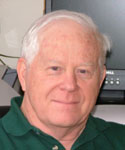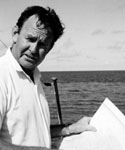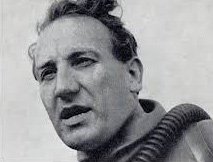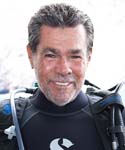The International Scuba Diving Hall Of Fame recently announced its 2015 inductees. This year’s induction ceremony will take place on Friday, October 2, 2015 at Grand Cayman.
The ISDHF recognizes those who have contributed to the success and growth of recreational SCUBA diving in the areas of dive travel, entertainment, art, equipment design and development, education, exploration and adventure. They award their highest level of recognition to those who have contributed significantly to these fields through their participation and promotion of recreational scuba diving.
The hall’s 2015 inductees include Bill High, Captain Wally Muller, Dimitri Rebikof, Dr. Albert Jones, and Peter Hughes.
Bill High
Bill High is being recognized “for his contribution to underwater science, the environment and the development of standards for scuba cylinder inspection and safety.” Bill is a marine scientist living in greater Seattle, Washington, began diving in 1955 and has maintained a constant involvement with the many  facets of underwater science, diver equipment, education and training. He led four extended saturation undersea laboratory teams (Tektite, Hydrolab, FLARE, Helgoland) and directed operations of five major deep submersible diving programs. He personally trained over 8,000 persons in basic or specialty diving skills and over 2,000 visual cylinder inspectors. He maintained a parallel career as a Emergency Medical Technician, Diving Medical Technician, hyperbaric chamber supervisor, and emergency room medic.
facets of underwater science, diver equipment, education and training. He led four extended saturation undersea laboratory teams (Tektite, Hydrolab, FLARE, Helgoland) and directed operations of five major deep submersible diving programs. He personally trained over 8,000 persons in basic or specialty diving skills and over 2,000 visual cylinder inspectors. He maintained a parallel career as a Emergency Medical Technician, Diving Medical Technician, hyperbaric chamber supervisor, and emergency room medic.
Bill High served as the first NOAA Diving Coordinator, Vice President of the Underwater Society of America, and President of the National Association of Underwater Instructors (NAUI). He is the recipient of numerous industry honors including NOGI Awards for Science, Sports and Distinguished Service, the Greenstone Award, PADI’s Outstanding Achievement Award, NAUI’s Hall of Honor, NAUI Lifetime Achievement Award, and DEMA’s Reaching Out Award. Bill is the only living diver to achieve 3 NOGI awards!
Bill is a prolific writer and photographer, having published more than 150 scientific or technical articles, several books, and over 200 photographs. He is a major contributor to each edition of the NOAA Diving Manual. He has published 5 editions of the book Inspecting Cylinders, which is recognized as the authority on high pressure cylinder inspection!
Single handedly, Bill researched and developed the technical training program for inspection of selected high-pressure cylinders. His devotion to life support cylinder safety influenced the gas industry throughout North America and at various international locations. The PSI-PCI, Inc. training is recognized by federal agencies, international governments, the U.S. Military, scuba instructors, fire industry associations, and cylinder manufacturers including Luxfer, Catalina, Pressed Steel Tanks, Structural Composites Inc, and Worthington.
Captain Wally Mueller
 Captain Wally Muller was a long-time fisherman, who explored reefs in the Great Barrier Reef’s Swain sector and the distant oceanic Coral Sea atolls which other captains avoided. He would later single-handedly established and developed the entire live-aboard industry in Australia’s outer Great Barrier Reef and Coral Sea. He is being recognized “for his contribution to the development of the live-aboard industry in Australia’s Great Barrier Reef and Coral Sea.”
Captain Wally Muller was a long-time fisherman, who explored reefs in the Great Barrier Reef’s Swain sector and the distant oceanic Coral Sea atolls which other captains avoided. He would later single-handedly established and developed the entire live-aboard industry in Australia’s outer Great Barrier Reef and Coral Sea. He is being recognized “for his contribution to the development of the live-aboard industry in Australia’s Great Barrier Reef and Coral Sea.”
Wally Muller helped the careers of many underwater cameramen during shark filming expeditions. International dive companies had almost booked-out Coralita during the late 1970’s beginning with Sea and See, then Bay Travel and later La Mer Diving Safari.
Marine photographers Irvin Rockman, Al Giddings (Titanic; The Deep) Jack McKenney (Sharks Treasure), Ron Taylor (Taylor’s Innerspace and many others) made use of Wally’s expertise in visiting remote, clear water shark habitats.

Stevens Housing: A 16mm movie camera and “Torpile” underwater light designed by Dimitri Rebikoff. Rebikoff designed many underwater camera and camer housings beginning in the late 1950s.
Dimitri Rebikof
Dimitri Rebikoff is being recognized “for his contribution to advancement of the diving industry through his design and development of major technological equipment and his literacy work.”
 The holder of more than 60 patents, Mr. Rebikoff worked for several years with famous aquatic explorer Jacques-Yves Cousteau. Among Mr. Rebikoff’s most lauded discoveries were a remote-controlled camera that allowed for underwater exploration and a portable electronic strobe light.
The holder of more than 60 patents, Mr. Rebikoff worked for several years with famous aquatic explorer Jacques-Yves Cousteau. Among Mr. Rebikoff’s most lauded discoveries were a remote-controlled camera that allowed for underwater exploration and a portable electronic strobe light.
As the World War II ended, Mr. Rebikoff stole a camera and made his way back to the newly liberated Paris, where he began picking up work as a photographer for the tabloids, specializing in color. In his spare time, he worked on inventions, mainly a portable electronic strobe light. He received French and Swiss patents on his invention, which led to his being recruited by a diving club to build a stronger strobe for underwater photography.
For two years, he worked for Cousteau to design and manufacture custom equipment for his underwater expeditions. He worked on Cousteau’s Oscar-winning movie, A World Without Sun. Cousteau’s early TV shows wouldn`t have been possible without Mr. Rebikoff’s cameras.
To make deep-water exploration possible, Mr. Rebikoff devised the remote-controlled Pegasus, which looked like a torpedo with handles and a camera mount. It was quickly taken up by scientists, who sent it under glaciers to explore fossil life, and by oil drillers, who sent it to the ocean floor. He designed the Pegasus as a towing device, with the diver mounted on top of the machine.
The original model is now on permanent display at the Smithsonian Institution. Mr. Rebikoff has sold them to the U.S. Navy, Israel, and England. He also found time to write books on diving and underwater photography.
Dr. Albert José Jones
 Dr. Albert José Jones is being recognized “for his contribution to the dive community through the development of clubs such as the Underwater Adventure Seekers, the National Association of Black Scuba Divers and his work with students in the marine and environmental fields.”
Dr. Albert José Jones is being recognized “for his contribution to the dive community through the development of clubs such as the Underwater Adventure Seekers, the National Association of Black Scuba Divers and his work with students in the marine and environmental fields.”
Dr. José Jones was an early pioneer and Instructor, who has been directly responsible for the development of many Dive clubs ranging from Underwater Adventure Seekers to the National Association of Black Scuba Divers with more than fifty branches. He continues to motivate and introduce students with his passion for marine science, environmental science and the career opportunities in these fields.
Peter Hughes
 Peter Hughes is being recognized “for his contribution to the innovation of the customer experience in the dive tourism industry, the advancement of the live-aboard market and the protection of the reefs.”
Peter Hughes is being recognized “for his contribution to the innovation of the customer experience in the dive tourism industry, the advancement of the live-aboard market and the protection of the reefs.”
One of the early Caribbean Instructors, Peter Hughes has been a major developer of Dive Resorts including Anthony’s Key Resort and Dive Bonaire before becoming Vice President of the network of Divi Resorts. He then entered the development of the live-aboard market with the Dancer Fleet, a field he still continues to be active in.
More Information:
International Scuba Diving Hall Of Fame
